#i put in an application for a terrier that’s at a local rescue but if i don’t get him i’m not trying again. i’ll take it as a hint
Text
I’m not sure if the seasonal depression is hitting especially hard this year or if I’m just grieving for Mabel or if I’m finally going irreparably insane or if life/people is being unfair towards me or all of the above
#i cry super hard every day now. sometimes multiple times a day#sometimes something sets it off specifically (like arguing with my mom earlier)#but sometimes i just think about mabel too much and start sobbing#i thought i was okay. i mean i knew i wasn’t okay but i knew time would do its thing#the first few weeks were the worst but earlier this month i felt like i’d kind of plateau’d#like i was still sad but i could look at photos and videos and talk about her without crying. i was even laughing#now… now i can’t even think of her. again#it just feels so fucking unfair that i’ll NEVER see her again. like what the fuck do you mean. what do you MEAN#what do you mean i have to live out my whole life… god knows how fucking long i’ll live; and N E V E R see her again. shut the fuck up.#that’s so fucking unfair. and everyone else is okay. i’m like how can you POSSIBLY just go about your life#the best dog in the world is dead and she’s going to stay dead and i won’t see her again for however many fucking stupid cursed decades#i live and i might not even see her when i die. how the HELL am i supposed to be okay with that. is that a joke#and there’s a part of me that’s like ‘maybe i could adopt another dog’ but i don’t know#i think i’d feel better and worse at the same time. i wouldn’t feel so alone but they wouldn’t be mabel#i put in an application for a terrier that’s at a local rescue but if i don’t get him i’m not trying again. i’ll take it as a hint#cats aren’t an option btw i found out i’m allergic. which was brand new information.. i’ve been around cats that didn’t set my allergies#off at all. but i guess there’s a difference between spending an hour at your friend’s house who has one cat#and living 24/7 with a cat that gets fur and dander and saliva everywhere#and i don’t think other pets would suit me. i just don’t feel comfortable caring for any animal i haven’t done research on#i had hamsters when i was a teenager but… tbh never again. they are so much fun but i have anxiety dreams about them now#so it’s dogs (well.. one dog) or nothing#i do have plans to speak to my doctor about my depression btw because i genuinely find this unsustainable#like i do think it’s situational (seasonal/grief/everyone around me seeming to want to argue with me lately) but i still need#mood stabilisers while i’m in this situation lol#personal
1 note
·
View note
Text
I’m so proud of Luca because I asked a lot of him yesterday and he rocked it.
We started at the busy dog park which is very unusual for us, so he could have easily been on edge. But he was great! We went to meet a foster with a local rescue. His name is Ned, he’s about a year old, a terrier mix of some kind. Luca was kind of into him. He didn’t have a strong reaction either way, and neither did I. I decided not to put in an application because they wanted it by this morning and I am not comfortable making a decision like this so quickly.
youtube
He was a really sweet dog though and definitely could have worked well with us if we had more time to get comfortable. But I don’t know if he was an agility prospect because I have no idea what to look for with that. Which is why I think I might just stick to my goal of getting a papillon eventually and ask the breeder to choose the right dog.
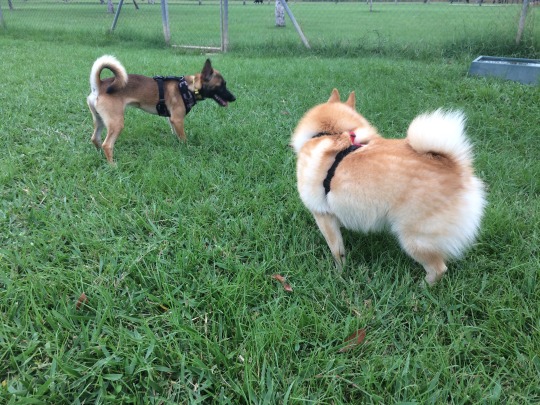
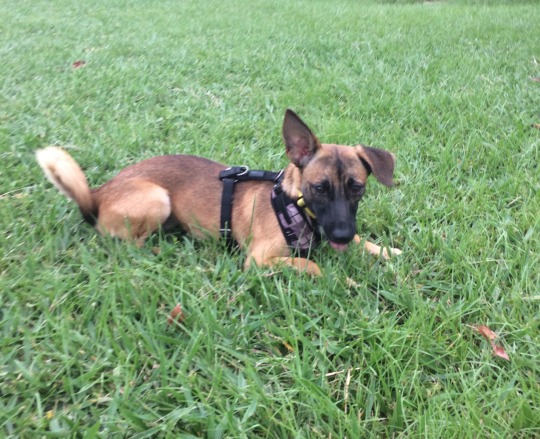
After about 20 minutes, we went on to agility training and I think having the run around first made him more chill because Luca actually settled while I was helping set up. He was also relatively close to some other dogs and didn’t seem too bothered. In fact, all night his reactivity was really great!
The format was the same as the first class we went to that was so successful – one at a time running, on leashes the rest of the time. I way way way prefer this. I think it’s the best use of time because you get your turn, then your dog gets a break and watching other people helps your learning as well.
Anyway, we got the chance to do multiple short runs focusing on technique. Our first go Luca was hesitant and kept coming to me between obstacles, but his confidence grew and he built up drive for at least five more setups. I also got to practice my crosses, did a lot of great front crosses and one successful blind cross. Blind crosses are difficult for us because we lose connection and Luca loses confidence. (I want to practice more on my own, but it’s difficult to find an environment with enough space and that’s safe for training.)
We were the very last ones on the last setup and by then he checked out, which I was OK with. I kinda wanted to make the run before that our last one because I had a feeling he was done. I wish I had done that, but oh well! Still really proud of my boy.
I never get any photos or videos at agility because I spend 100% of my time focused on Luca in terms of either training or managing his reactivity. I’m thinking of bringing my camera and tripod next week and filming everyone’s runs though, but not sure if I have the battery capacity for a full hour.
#Luca#dog training#dog agility#the foster carer was like 'The shelter said part basenji'#I held my tongue#I was just like 'Huh'#lmao basenji#in Darwin#sure#definitely#also at the end when Luca didn't want to run anymore#inevitably#INEVITABLY we got the comment 'Too hot now in that fluffy coat!'#and I'm just like y'all#half of the dogs here have double coats#what makes you think my dog is the only one suffering?#he seems fine to me#not to mention he has lived in this exact weather since he was 3 months old
36 notes
·
View notes
Text
[Breeds] Looking for a dog for our young family via /r/dogs
[Breeds] Looking for a dog for our young family
Looking for a dog that would like hiking and would enjoy living in our London suburb mid-terrace house with our 2 year old son and our cat. A rescue would be wonderful if we could make it happen.
Introduction
1) Will this be your first dog? If not, what experience do you have owning/training dogs?
My wife and I both had medium sized dogs growing up (a retriever and a some sort of lurcher mutt). We both remember our parents training them and are pretty confident we'll do okay. My wife dog-sat for neighbours as well
2) Do you have a preference for rescuing a dog vs. going through a reputable breeder?
We'd love to rescue, but with a toddler (2 yr) and a cat we may be out of luck. The dog homes here in the UK are notoriously cautious. Would love recommendations on how to handle them and adopt the right dog!
3) Describe your ideal dog.
Cheerful and playful, safe around kids and grandparents. Ready to play fetch or wrestle a bit. Perhaps a bit smarter than the average. Doesn't need to run constantly, but will happily come along with us on hikes around 10 miles.
4) What breeds or types of dogs are you interested in and why?
Some spaniels seem like a good balance of this. Considering schnauzers, bigger terriers or beagles as well, though I'm not sure how well they hike.
5) What sorts of things would you like to train your dog to do?
I'm not fussed about tricks, but it would be super useful if it was comfortable traveling on public transport. Fetch would be great but plenty wonderful dogs won't even let you near their sticks.
6) Do you want to compete with your dog in a sport (e.g. agility, obedience, rally) or use your dog for a form of work (e.g. hunting, herding, livestock guarding)? If so, how much experience do you have with this work/sport?
No thanks
Care Commitments
7) How long do you want to devote to training, playing with, or otherwise interacting with your dog each day?
We don't expect to do much training beyond basic obedience, housebreaking and public transit. In the post-covid world at least one of us will be working from home every week day so they won't get lonely, but we will need to work during that time so a dog needing constant attention would be a problem.
8) How long can you exercise your dog each day, on average? What sorts of exercise are you planning to give your dog regularly and does that include using a dog park?
We are expecting as much as an hour's walk including a dog park in the morning, with a shorter walk in the evening. Plus running in our back garden during the day (~30 meters), and longer walks at weekends.
9) How much regular brushing are you willing to do? Are you open to trimming hair, cleaning ears, or doing other grooming at home? If not, would you be willing to pay a professional to do it regularly?
We would happily do the grooming as necessary and there are plenty of professionals in our area. I think we lean away from the truly hairy breeds, but more guided by their comfort in our climate.
Personal Preferences
10) What size dog are you looking for?
Probably small to medium. We love large dogs, but while our house is decent size for London it is not huge and will need to be shared with 2 adults, a toddler and a cat.
11) How much shedding, barking, and slobber can you handle?
Slobber and shedding is fine and fun and part of dog life. Barking we are less keen on (and we also have neighbors with whom we share walls)
12) How important is being able to let your dog off-leash in an unfenced area?
The dog will have to be able to behave itself at a basic level to handle parks and country walks. I would say this is probably pretty important.
Dog Personality and Behavior
13) Do you want a snuggly dog or one that prefers some personal space?
Probably medium? Love having a dog that puts their head in our lap and tries to lick our face. But again we will need to work from home around them, so yapping until we pick them up could become a problem.
14) Would you prefer a dog that wants to do its own thing or one that’s more eager-to-please?
I like anywhere on that spectrum, though perhaps not fully aloof. I would say it's more important that they are able to relate to kids. Guess would probably be more eager to please, but not really sure.
15) How would you prefer your dog to respond to someone knocking on the door or entering your yard? How would you prefer your dog to greet strangers or visitors?
I'd rather they be open to strangers. Having a dog with a guard mentality might be tricky in a mid-terrace house with neighbors close by. Barking a bit when someone knocks is fine, but they should accept people when we bring them inside.
16) Are you willing to manage a dog that is aggressive to other dogs?
I don't think that's a good idea. Just too many around here.
17) Are there any other behaviors you can’t deal with or want to avoid?
Avoiding too much barking is probably the main one. We can manage if they turn out to be yippy (you never know) but we are keen to be kind to our neighbors.
Lifestyle
18) How often and how long will the dog be left alone?
One of us should be working from home every weekday and we will be around weekends. I would say that it would be good to be able to leave them for half a day sometimes, but we should be able to get people to look in on them if it's longer than that. We have good neighbours and friends locally who could help.
19) What are the dog-related preferences of other people in the house and what will be their involvement in caring for the dog?
Us two adults are both very keen. We will see about our toddler as he ages but mostly seems fine.
20) Do you have other pets or are you planning on having other pets? What breed or type of animal are they?
We have a rescue cat (normal british short-hair) whom we have had for 3 years now and is about 5 years old. She has a cat-flap and we are planning to keep the dog out of at least a room or two to help her.
21) Will the dog be interacting with children regularly?
Yes, being good with our kid and their friends is essential.
22) Do you rent or plan to rent in the future? If applicable, what breed or weight restrictions are on your current lease?
We own and are planning to stay.
23) What city or country do you live in and are you aware of any laws banning certain breeds?
London, UK. There are laws about breeds which are said to be violent.
24) What is the average temperature of a typical summer and winter day where you live?
Summer hovers around 20°C most days, but gets up to 25-30°C, almost never more than that. Humid but not muggy. Winter is not below freezing all that often. A week or so of light snow in total is not unusual, but fairly mild overall.
Additional Information and Questions
25) Please provide any additional information you feel may be relevant.
We would really love to rescue a dog, but are not sure how we could do that since we have a toddler and a cat. Rescue charities here are very restrictive and we have so far not seen any dogs listed as ok for both small children and cats. Should we just give up on this approach? Is there anything we should try?
26) Feel free to ask any questions below.
I loved my mutt growing up. I recognize breeders would probably not call any of their dogs mutts, but is there any way to let breeders know we would be interested in, let's say unconventional cross-breeds?
Submitted July 26, 2020 at 06:43AM by subsetOfInsanity
via reddit https://ift.tt/39wwknm
0 notes
Text
High Country Tenderness
It’s a dramatic and spirit-lifting drive along the six-mile stretch of NC Highway 18 from Cumberland Knob Recreation Area in Surry County, NC, to the community of Ennice in northern Alleghany County. The highway unrolls to the west like a ribbon along the ridgetops, almost in sight of the Virginia state line. To the south and west, long, peaceful views of grazing cattle and symmetrical fields of boxwood and Christmas trees undulate toward Bullhead Mountain, a landmark on the Blue Ridge Parkway. Beyond Ennice, the road runs down to the county seat of Sparta, where I was headed for a weekend of food and festivities associated with my book, The Month of Their Ripening. I was hosted by Alleghany Writers, a scrappy literary group with a big vision in this small mountain county populated by hard working farmers and joyful retirees. Some residents qualify in both categories, as did the two families I met on the first day of my visit.
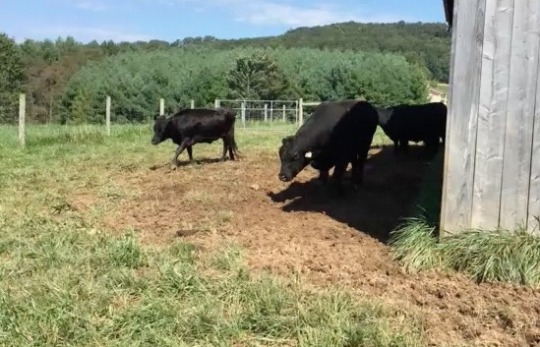
The visiting bull (right) on the move to a different pasture
Before moving permanently to Alleghany County, Ricky Brown lived in several NC cities as a senior bank executive. He and his wife, Kim, had been childhood sweethearts in the eastern NC town of Robersonville in Martin County where cotton and tobacco are the primary products. The Browns moved into the cattle business when their daughter Sara declared she wanted to become an organic farmer. While Sara went off to study at The Farm School in Athol, MA, followed by a volunteer stint for Heifer International, Ricky took early retirement and found some 175 rolling acres that had formerly been planted in Christmas trees. Then Kim’s sister Lynn Perry and her mother, Doris Perry, joined the Browns in the mountains.
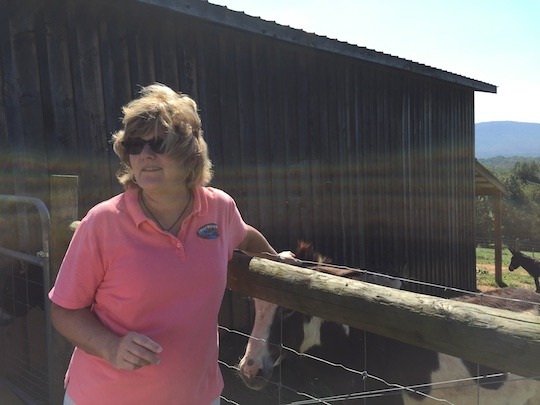
Chilly Water Farm’s Kim Brown and Levi, a standard donkey
Today Chilly Water Farm raises Dexter and Angus beef cattle without hormones and antibiotics. The herd feeds exclusively on grass and hay, rotating every two days through a series of paddocks that keep the pasture grass thriving. Each year Chilly Water sells a limited quantity of high quality steakburger meat by the pound to local customers and to select Winston-Salem restaurants.
“The burgers are made from everything but the short ribs and soup bones,” Kim explained, as we set out toward the chicken pen. (Chilly Water also sells eggs and uses chicken fertilizer for the garden.) “We recently got rid of the rooster,” Kim continued. “He drove the girls crazy. They didn’t need that. We are all about harmony here.” She grinned.
The farm menagerie involves several dogs, including a Jack Russell terrier named Opie, a standard donkey named Levi, and eight miniature donkeys, all female, who keep him company.
“These animals are for nothing but peace and joy,” Kim said, as the small herd trotted over to greet and nudge us for head rubs along the fence. Nearby, Little Jack, a rescue goat, was penned with his companion, Watson, also seeking an audience with the humans. More goats played up the hill in a separate pen near an heirloom apple tree that was loaded with yellow fruit. Kim explained that only the goat named Elvis could possibly be a candidate for a meal, leaving us to wonder about his offenses.
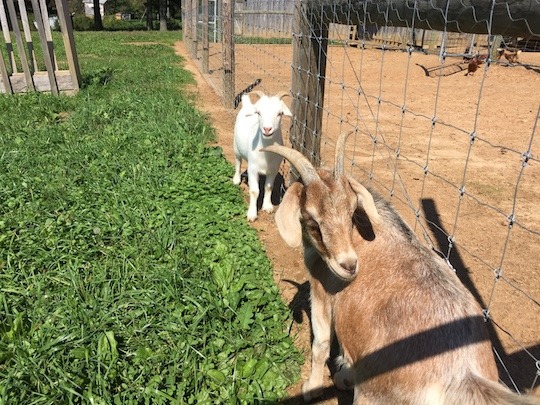
Watson in foreground and Little Jack, the rescue goat
After paying our respects to these “house” animals, sister Lynn joined us as we climbed onto a four-seat gator and sailed across the pristine fields to get a closer look at the horses and cattle down in the holler, including an enormous visiting bull who quickly showed us his stuff. We laughed as Lynn put on her mucking boots and hopped off the vehicle to lead the herd through the gate to their next grazing destination. Then we shot forward again, bouncing and angling downhill and then uphill again on a washed-out trail through dense white pines, mature hardwoods, and an occasional Norwegian fir.
When we stopped to observe the pond from the far side of the woods, the sisters reminisced about their grandmother’s unforgettable molasses cake recipe that they had asked her to share with them as her health was failing. The ingredients, as it turned out, were the last words she spoke to her granddaughters. “But when we made it, it didn’t turn out like we remembered,” said Lynn, now amused by the memory. “I think she maybe didn’t give us all that the cake called for.”
“Of course, she never measured anything anyway,” Kim added. “Just a pinch of that and a spoonful of this.”
Back at the house, Ricky had cooked juicy and tender steakburgers on the grill and Doris set out a buffet of green beans, okra, fresh sliced tomatoes, stewed apples from the tree outside, and crisp homemade pickles and jalapenos. After such a feast, I hated to leave Chilly Waters, but I presented my kind hosts with a signed copy of the book and headed out to my next destination.
***
Frances Huber grew up in the toney Buckhead section of Atlanta but started coming to Alleghany County for family retreats as a ten-year-old. Now, just past 80, she is raising Angus breeding stock. She used to sell her cattle for beef, but today she raises the original Angus that have shorter legs and carry more meat than their big-boned, genetically modified relatives. “Now I don’t have to apologize when I sell them off,” Frances explained, “because they are not going off to be processed but are headed for breeding.”
Huber, assisted by a full-time farm manager and an occasional student intern, also raises all-natural, forest-grazing hogs that were lolling around the edge of the woods alongside the cattle as I made my way down the treelined drive to the two-story frame house that she and her late husband, Andy, built in the 1990s.
Long before her organic farming adventure started, Frances read Rachel Carson’s Silent Spring and developed an interest in holistic medicine. With Andy, who was a Cornell graduate in agriculture, the Hubers bought this abandoned dairy farm in 1994 and raised hay and horses without the use of chemical fertilizers, herbicides, or pesticides. “The weeds will tell you what’s wrong with your soil,” Frances explained. She taught herself how to correct deficiencies in the dirt with natural applications of minerals such as gypsum to get the pH right.

Frances Huber of Brush Creek Farm
After her husband died of a debilitating cancer of the spine in 2000, Frances did not want to leave the farm. With her daughter’s help, she opened the land to families and busloads of schoolchildren who visited her newly acquired collection of petting animals. She also created a store and planted a whimsical garden on the farm. While she loved the children who came to visit and learn from her, Frances said, “It was like running Carowinds. Too much.” She laughed.
Now Huber has put her 200-plus acres into conservation easements, including the land that provides the most extraordinary view from her screened porch toward Bullhead Mountain. She then challenged her children to come up with a crop they could raise on a portion of the land. The only requirement was that no chemicals be used in the process. Her son who is a bond trader and her daughter who is in marketing came up with the idea of hops and planted citrus hops from five sources last year on a single acre. “An acre of hops is a lot,” Frances said. “I told them I would give them the rest of that sloping field if it went well.”
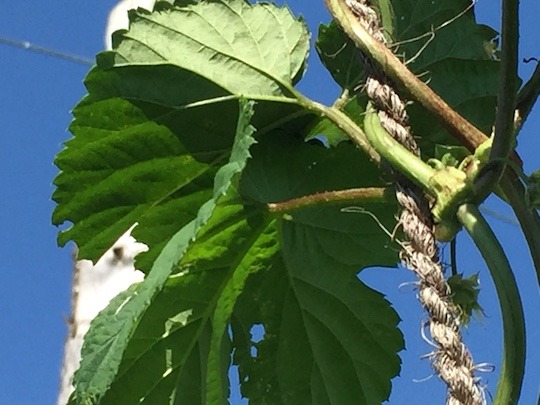
Hops growing on a rope of organic hemp
I had never seen hops growing. Though most of the first crop had been harvested by the time of my visit, a few vines still climbed upward from the ground on organic hemp ropes suspended from wires strung high above on ten-foot poles that were set out in a grid pattern. Clearly the infrastructure for this crop took no small effort to construct. Frances explained that they had to hire a grappler to install the poles while two of her grandsons helped to site and move the heavy poles. Huber’s daughter spent hours digging trenches out of thick sod between poles and amending the soil under the wires where they would plant the ten rows of hops. Each row required constant weeding. The siblings chronicled each variety carefully and found no signs of mildew, though some bugs did come along. They declared the first harvest a success. Frances now admits that she was not sure if the kids would pull it off, but they did. Their new business cards say “Huber Hops.” Perhaps these flavorful ingredients will be coming to a craft brewer near you.
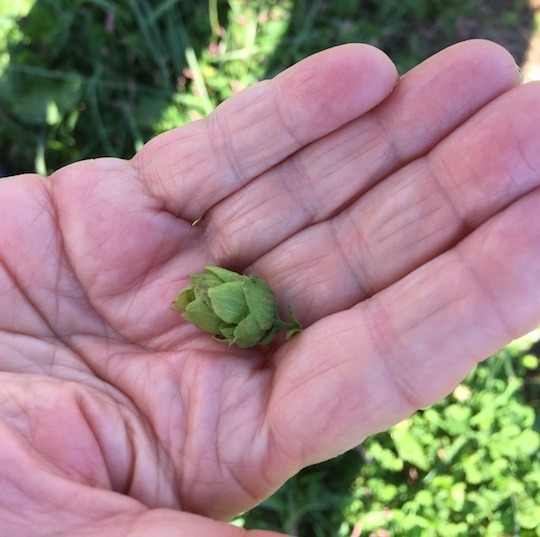
Hops in hand
Two nights later, before I gave a talk about the new book at a farm-to-table dinner for seventy guests in support of the Alleghany Writers’ Development Fund for creative writing in the local schools, I had a chance to sample Frances Huber’s Brush Creek Farm pork tenderloin and chorizo. Local chef Garrison Wagoner used the just-this-side-of-fiery chorizo to stuff succulent mushrooms. It was a most satisfying burn.
The tenderloin served next needed no accompaniment. Huber’s forest-fed pork was like none I have ever had in memory. Soft, sweet, tender, pale, and without any obvious grain in the meat nor toughness. In short, remarkable. A few days later I would hear just the right phrase, supposedly posted outside a BBQ joint in Mississippi—“You don’t need teeth to eat our meat.” That is how tender it was and how easy the visit to this rural enclave. Thanks to Alleghany Writers’ leader Ginger Collins, the Brown family, and Frances Huber for the high-country hospitality.
Need an autographed copy of The Month of Their Ripening for a gift? Write me: georganneubanks9 (at) gmail.com
0 notes
Link
Written by R. Ann Parris on The Prepper Journal.
Editors Note: Another article from R. Ann Parris to The Prepper Journal. Admit it, when you saw the title you thought this was about one of the Internets search engines. Alas, and thankfully, it is about something so much more important. If you have information for Preppers that you would like to share then enter into the Prepper Writing Contest with a chance to win one of three Amazon Gift Cards with the top prize being a $300 card to purchase your own prepping supplies!
Search and Rescue codes largely entered mainstream American awareness in the U.S. courtesy of massive hurricane disaster areas. We saw them before Katrina, although she brought them into American homes and still bears their scars, and sadly, we’ve seen them since and will likely continue to see them.
For preppers, there are two main reasons to understand the most common codes used to mark structures by teams in a disaster area.
One, there’s the counter-intel aspect. They can be used as camouflage, misleading others about our home or the entire area around our home – which can keep others from even getting close to us if applied properly.
*Be able to cover or remove markings especially if applied to a whole neighborhood in case a real disaster occurs and somebody is able to respond. If it looks like another unit checked the area or has done follow-up recently, they may assume SNAFU is in full effect and hop the block/road to work an area that hasn’t been covered yet.
Two, we can use them to gather intel should we find ourselves moving through a disaster area.
Let’s hit that “moving through” aspect, because there’s usually a lot of resistance there.
There are all kinds of reasons we might be out and about after a disaster, whether that disaster is what drove us out or we wander into the aftermath of a disaster while passing through.
Straight from the news: air, surface, and ground water contaminated by chemical spills from trains, factories, mines, and ships; housefires, wildfires, and droughts, which then exacerbate rain into floods and mudslides; upstream dams and levees failing; natural disasters kicking off fires, releasing previously contained toxins, cracking wells, tumbling houses, and wrecking cellars.
That’s not the what-if of a paranoid prepper.
That’s straight from the news.
Fires occur and spread daily – it’s why you have a fire department. Annually, monthly, weekly, we get things beyond our individual control, already causing people to relocate or find alternate resources even with all our technical advances in our nice, modernized nations.
That’s not the WROL (Without Rule of Law)/pandemic human-contact concerns, or the cooling tanks in nuclear plants steaming off over days or 2-20 years. It’s not droughts lowering water tables, animal plagues, or woods too emptied of trees or animal/plant foods to sustain another winter and spring. It’s not somebody traveling even “just” 30-100 miles from home before a disaster strikes.
Using just things that happen, pretty regularly, portions of the population are forced from homes that had seemed like perfect locations.
There are all kinds of reasons to include a Plan B (or C,D,E…) that involves traveling, and not always in nice, empty backcountry.
Being able to recognize what we’re seeing from either the “safe” resource site or avoidance perspectives while passing through is huge.
We can also plan to learn the CDC and HazMat codes that may become applicable even in our local neighborhoods.
Recognizing where we don’t want to be is one of the biggies for gaining International Search and Rescue Group – INSARAG literacy.
Lots of bodies, no marks for reclaiming them, disease is hella prevalent, pretty much guaranteed. I would rather not pick through a building that was already so questionable a search team opted not to press a full search. If it was already overrun by rats “then”, unless I’m desperate enough to eat them, I’d really rather hop well out of that neighborhood before we find a bed-down pocket.
We can learn lots of things when we know how to read INSARAG. The dates and updates alone can give us information about the area, human climate, and resource potentials.
Disaster Search Codes
In the U.S. we mostly use and see FEMA “X” codes – a circle divided into quadrants. Other NATO nations use a circled box.
There’s also a separate box that’s part of a three-tier structural integrity rating.
Take that with a grain of salt, because it’s “significant” hazards. Lesser risks that were no big deal in a mostly functional world can deliver a world of hurt if we’re already working with limited resources.
It’s also being assessed by teachers, lawyers, random National Guard types, clerks, landscapers, and cops, as opposed to firefighters, who develop a good eye for these things, or qualified civil engineers.
Those X’s that denote a big issue are worth paying attention to, period. Something stuck out at them to be marked. If that box is empty or “just” a slash … again, it was probably not cleared by professional housing inspectors. Be super-duper leery anyway.
There’s also a victim-location code based around a V. It’s sometimes used on its own, but it’s most commonly seen as an add-on.
All three contribute to streamlining both initial searches and follow-ups or retrieval operations. They convey basic information like the date, status of the structure, victim information, and risks.
There’s some personal twists added sometimes, some specific-unit tweaks and shorthand, and in some cases, simplification and deviations that develop in really widespread disasters.
The variations can help us if we’re using them along with noise and light discipline to discourage incursions during excessive loss of rule of law or by looters/survivors after a disaster.
Anyone familiar enough with the codes to accurately read what we’re saying will expect to see some of those deviations. However, if you put information in the wrong place or use some random combination, you may actually attract attention.
X codes are most common in the U.S. but it’s worth learning what you’re seeing in NATO INSARAG boxes and reading-writing victim V-codes, too.
FEMA “X” Search Codes
Top goes the date (and rarely the time). Left goes the unit that’s searching (and sometimes the time). Hazards, actions we took, and special notes go to the right.
Everybody knows a flood means human waste, wood rotting as it goes, and mold developing, but if the floor’s crumbling already, that gets put there with “hamster removed” and “GL” (gas or fuel leak visualized or smelled).
That’s also where a no-go, break-off, or exterior-only survey is noted, with or without a secondary structure box.
In the bottom, a zero or empty quadrant means nobody’s home, dead or alive. Victim counts are listed live to dead, top and bottom or left to right separated by a dash, dot or slash.
FEMA now advises to mark search results on windows and doors, and use their big stickers when available, instead of wrecking house paint and siding. If local teams are doing it and you’re aiming for camo, mimic them.
*If you’re marking for an animal rescue that’s coming through after you, make it Big and Bold, and note if it’s going to require saws/jacks to get them out.
Top Three Super-Duper Big-time Warning Signs
One, there’s that “no go” structural safety box with the X. If professionals with healthcare did not want anybody else to poke inside, that’s a real good one to skip.
Two, we want to be hyper-vigilant for the word “dog(s)” somewhere.
Now, I like dogs. I like my dogs a lot. But, my dogs make me very, very aware of other dogs. Especially my current girls, because they – Lab-terrier mixes, never strays, never starved, never abused, with no training for it – will separate, hug verges all nonchalant, easy-going postures, and then launch for takedown from multiple angles like a pack of lionesses.
So I watch for whether dogs are happy to see people, period, or happy and excited about chasing something that’s not as athletic as a squirrel. And I watch my flanks for others.
Three, we want to be very leery if we ever see a single diagonal slash with or without a date.
See, we’re trained to mark a slash – and, unit by unit, the date-time – before we enter a building or floor/area/apartment in large buildings. If we abandon a search before we finish, we are supposed to paint a dot/circle in the middle of it. (Completed searches get the X, even if it’s “did not enter/exterior survey only – hazards”.)
Even if we’re leaving in a hurry, we’re supposed to put that dot on there.
That way if we don’t make our rally or contact, people know right exactly where we are. No question of did we get snatched off the porch, have an accident after leaving the building, or which building, floor, or compartment we bounced to next. If we drew that single slash and there is no other marking (+/- the date), we are still within that threshold.
This applies to preppers as “oh my my” because if there is only that slash, we have two conditions.
One, there is still a team inside. Maybe good, if we’re seeking other intelligent life. Maybe cause to fade away if we want to go unnoticed.
Two, the searcher(s) went in and either did not come out or something so bad happened inside that they un-A’d the AO in such a rush they didn’t even take time for another slash and an X-box.
That suggests, right up there with dogs, bodies, and compromised structures, that we do not want to go through that door.
*If you’re aiming for camo in EROL conditions, don’t use that one. SAR, first responders, and military will go in after each other almost as fast as if we heard a crying baby.
Now, shorthand/personalization that develops in widespread disasters means some never even drew a slash. But if we see just that slash, that is a warning sign.
Applying INSARAG Markings
INSARAG can provide intel on local conditions just by the quickie versions that suggest more need than available CERT/SAR teams could handle, and give us the number and types of teams working an area.
We can also use clues from how they’re marked. For instance, any time markings seem really high up on a building, or have serious up-down wavering of lines, circles undulating like scalloped pattypan squash, or oval “tornado spirals” instead of circles, it indicates a flood high enough that it was easier/safer to stand in a boat to paint than be in the water. Heights and dates of marks can tell us if water was rising or receding.
On the counter-intel front, we can use things like follow-ups and some of those super-duper bigtime warning signs to disseminate false information, projecting that fires gutted flats or stores, or there’s heavy mold and decaying bodies, etc.
They’re worth being familiar enough with to plan our actions to mitigate likely risks, choose avoidance of an area, or pick locations that may still have useful resources with the safest access, even if we’re not planning a bugout, ever. Too much goes wrong even right now to steadfastly insist we’ll never be away from home and traveling, or ever be forced out of our homes.
Follow The Prepper Journal on Facebook!
The post X Marks the Spot – Search Codes That Matter to Preppers appeared first on The Prepper Journal.
from The Prepper Journal
Don't forget to visit the store and pick up some gear at The COR Outfitters. How prepared are you for emergencies?
#SurvivalFirestarter #SurvivalBugOutBackpack #PrepperSurvivalPack #SHTFGear #SHTFBag
0 notes
Link
Learn Some Tips When Possessing A Dog.
The distinctiveness of dogs is why them so special. Such as you or I, each features its own personality, needs and wants, and temperament. That said, there exists some basic advice which is applicable to dogs overall, so you need this information to look after your pet properly. This article details what you ought to know to begin.
If you are looking for the great family pet, however are within a strict budget, consider rescuing an animal.You will get one with a local shelter for minimal costs and the dog include a clean bill of health and all his shots. If you are considering a particular breed, contact a rescue group specializing in solely those pooches.
Keep the dog’s teeth in tip tip condition. Just like humans, a pet dog can have problems with toothache, gum disease as well as tooth loss. Regular brushing will assure that that his teeth and gums remain healthy and robust. Without regular brushing, it is estimated that dental disease will affect around 80% of dogs by the age of three. In addition to dental cleaning from a vet, ensure that you brush your dog’s teeth regularly.
If you’re on a tight budget in the home, think carefully just before a dog. They actually cost several hundred dollars annually, but many people don’t realize this until they’ve actually forked over the money. Dependant upon the size and regular maintenance requirements of the new dog, you could be getting in way over your face and required to part with him later so make certain beforehand.
Brush your pet often, even though he’s got short hair. It’s beneficial to his coat and skin and might alert you of possible issues like fleas, tics and eczema. The canine will even benefit from the attention and brushing him regularly will keep a greater portion of his fur from flying around the house and landing on the furniture and carpets.
To shield your pet in the case he or she is lost or stolen, have a microchip surgically implanted by your vet. These handy chips store data that can be retrieved by way of a shelter or animal officer and accustomed to contact you. They may be painless to place in and provide reassurance to the pet lover!
Trim hair around a dog’s paws so that hair mats don’t form. Work with a comb first, then start cutting. In the event you don’t feel relaxed achieving this, take your puppy to a groomer.
In case your dog is vulnerable to getting burs in the coat, have a can of Crisco in your kitchen cupboard. The next time you find a bur, put gloves on to protect yourself and work the Crisco around before you can pry the bur out. Give him a good shampoo to find the shortening out later.
Make time for the dog. Maybe you are aware your pet dog always has time for yourself, so it’s a chance to return the favor. You may take the dog out for some exercise, or you may just set a while aside to rub his belly. Be sure you spend a certain amount of special time together with your dog, and he’ll appreciate it.
Take note of your dog’s breath. Dogs will have “dog breath,”? however, really bad breath is a sign that they need a dental examination. Plaque buildup caused by bacteria could possibly be the culprit and therefore will need to be treated by way of a professional. After their treatments, you will need to brush their gums and teeth and feed them food that helps maintain good dental health.
If you have tried everything  home family tv to have your dog to quit digging your garden to no avail, visit your house. Mix up a batch of cayenne pepper (five tablespoons), hot sauce (also five tablespoons) plus a quart water inside a spray bottle and spray it where he digs. It ought to discourage him quickly.
Make use of an essential olive oil spray to maintain your dog’s dish sparkling clean. Particularly if feed him canned food, it may quickly cake-up and dry on the inside of the bowl, rendering it difficult to wash later. Like a bonus, the essential olive oil will assist you to keep his coat shiny too.
Be sure you carefully consider what feeding program you may use with the dog. There are many forms of pet food to choose from, however you must locate a kind of food that is right for your dog’s size and age. Feeding leftovers to some dog could save money, but a suitable diet is harder to preserve together eating leftovers.
These simple tips for looking after your pet dog apply whether your pup is really a terrier or possibly a retriever, old or young, furry or hairless. That is what makes using whatever you learned so important – you know it is going to apply with your situation! Love your pet daily by doing everything you can to be the better owner.
Source:http://sweetbabyphoto.com/sound-advice-to-have-a-highly-behaved-dog/
from Pablo Chambers Sweet Baby Photo, Southern California Baby and Child Photographer:: Serving Orange County, the InIand Empire, Los Angeles and San Diego https://pablochamberssweetbabyphoto.wordpress.com/2017/06/01/sound-advice-to-have-a-highly-behaved-dog/
0 notes
Link
Learn Some Tips When Possessing A Dog.
The distinctiveness of dogs is why them so special. Such as you or I, each features its own personality, needs and wants, and temperament. That said, there exists some basic advice which is applicable to dogs overall, so you need this information to look after your pet properly. This article details what you ought to know to begin.
If you are looking for the great family pet, however are within a strict budget, consider rescuing an animal.You will get one with a local shelter for minimal costs and the dog include a clean bill of health and all his shots. If you are considering a particular breed, contact a rescue group specializing in solely those pooches.
Keep the dog’s teeth in tip tip condition. Just like humans, a pet dog can have problems with toothache, gum disease as well as tooth loss. Regular brushing will assure that that his teeth and gums remain healthy and robust. Without regular brushing, it is estimated that dental disease will affect around 80% of dogs by the age of three. In addition to dental cleaning from a vet, ensure that you brush your dog’s teeth regularly.
If you’re on a tight budget in the home, think carefully just before a dog. They actually cost several hundred dollars annually, but many people don’t realize this until they’ve actually forked over the money. Dependant upon the size and regular maintenance requirements of the new dog, you could be getting in way over your face and required to part with him later so make certain beforehand.
Brush your pet often, even though he’s got short hair. It’s beneficial to his coat and skin and might alert you of possible issues like fleas, tics and eczema. The canine will even benefit from the attention and brushing him regularly will keep a greater portion of his fur from flying around the house and landing on the furniture and carpets.
To shield your pet in the case he or she is lost or stolen, have a microchip surgically implanted by your vet. These handy chips store data that can be retrieved by way of a shelter or animal officer and accustomed to contact you. They may be painless to place in and provide reassurance to the pet lover!
Trim hair around a dog’s paws so that hair mats don’t form. Work with a comb first, then start cutting. In the event you don’t feel relaxed achieving this, take your puppy to a groomer.
In case your dog is vulnerable to getting burs in the coat, have a can of Crisco in your kitchen cupboard. The next time you find a bur, put gloves on to protect yourself and work the Crisco around before you can pry the bur out. Give him a good shampoo to find the shortening out later.
Make time for the dog. Maybe you are aware your pet dog always has time for yourself, so it’s a chance to return the favor. You may take the dog out for some exercise, or you may just set a while aside to rub his belly. Be sure you spend a certain amount of special time together with your dog, and he’ll appreciate it.
Take note of your dog’s breath. Dogs will have “dog breath,”? however, really bad breath is a sign that they need a dental examination. Plaque buildup caused by bacteria could possibly be the culprit and therefore will need to be treated by way of a professional. After their treatments, you will need to brush their gums and teeth and feed them food that helps maintain good dental health.
If you have tried everything  home family tv to have your dog to quit digging your garden to no avail, visit your house. Mix up a batch of cayenne pepper (five tablespoons), hot sauce (also five tablespoons) plus a quart water inside a spray bottle and spray it where he digs. It ought to discourage him quickly.
Make use of an essential olive oil spray to maintain your dog’s dish sparkling clean. Particularly if feed him canned food, it may quickly cake-up and dry on the inside of the bowl, rendering it difficult to wash later. Like a bonus, the essential olive oil will assist you to keep his coat shiny too.
Be sure you carefully consider what feeding program you may use with the dog. There are many forms of pet food to choose from, however you must locate a kind of food that is right for your dog’s size and age. Feeding leftovers to some dog could save money, but a suitable diet is harder to preserve together eating leftovers.
These simple tips for looking after your pet dog apply whether your pup is really a terrier or possibly a retriever, old or young, furry or hairless. That is what makes using whatever you learned so important – you know it is going to apply with your situation! Love your pet daily by doing everything you can to be the better owner.
Source:http://sweetbabyphoto.com/sound-advice-to-have-a-highly-behaved-dog/
0 notes